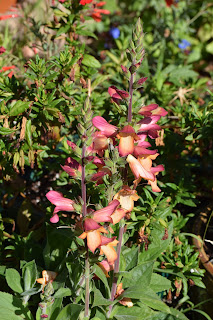Aretha Franklin fans will catch the title of this blogpost but for me it's about the matter of today's photos. Today I used my zoom lens to take close-ups of flowers. Ironically, a lens that's usually used for long distance shots turns out to be good for photographing smaller flowers. And now that I have a body that supports Auto-focus, it can focus itself, rather than me relying on a steady hand.
So, that said, here are some mid-October photos showing that yes, it's still late summer, no matter what the calendar says.
Azalea Court Jester. This sport is from Kenny at Moraga Garden Center. The flowers can be all different, one from the other, with some showing more orchid pink streaking and others less.
Hibiscus trionum. Still one of gardening's best kept secrets. This lovely, herbaceous hibiscus is a prolific bloomer, with buds seeming to develop overnight. Though there's just the one color - a creamy white with burgundy centers - they bloom over a long season in summer and fall.
I think some people naming varieties of plants must be doing so after fasting. So many food names. Here's another one - Justicia Fruit Cocktail. It too is a prolific bloomer. Love the chartreuse bracts!
Nerine humilis.This South African bulb has the prettiest coral flowers.
Opuntia species. Still have yet to nail down the species or variety of this prickly pear cactus and am still waiting for it to bloom.
You need a zoom to catch the petite charms of the small Evolvulus flowers. One of the truest blues and for me a reliable and long blooming perennial.
There are summer oxalis and winter oxalis. Here's a winter blooming type that's come up a bit early. Love the contrast of the white flowers against the mint green leaves.
Monardella odoratissima. This long blooming Coyote mint has been a real standout in my garden. Seemingly always in bloom, it attracts a variety of butterflies and moths.
Agastache Blue Fortune. This Hummingbird mint also attracts bees (as do most of my Agastache). I seem to be in a purple phase these days.
Santolina Lemon Fizz. This diminutive herb/ornamental has its own charm, from its petite form, to the bright chartreuse color to its scent (which some like and others do not).
My Mandevilla Apricot is late to bloom this year (as are many things in my garden). Here's its first flower of the year. Incidentally that streak of white on the right side is sap from the towering Asclepias cancellata above it. I'd snapped off a couple of leaves for a less obstructed view and they bled onto the flower.
Digiplexis Illumination Flame. I seem to alternate between good years and bad for this plant. This year's been a good one and I'm sure there's plenty more flowers to come.
Cussonia natalensis is considered a caudiciform and here's evidence of that. This fattening trunk still holds some gnarly charm.
This Hibiscus Adonis Pearl is part of the HibisQs line, a new hybrid of Hibiscus whose flowers stay open much longer than traditional Hibiscus (5-6 days as opposed to 1-2 days).
My Sphaeralcea Newleaze Coral has been nothing short of amazing. In bloom continuously since February, it just keeps pumping out these sweet half inch coral-red blooms.
I'm thinking of naming this Freylinia 'Shelley', after the Sesame Street turtle. That's because it's one of the slowest growing plants I've ever had in my garden. Month to month this Aussie native hardly seems changed.
My Tecoma x smithii is the opposite to the Freylinia. Quick to grow, quick to take over an area, quick to bloom. Which is all good for me as it can't escape anywhere. Here's a close-up of its richly colored flowers.
A zoom lens is needed to do justice to the tiny but oh so blue flowers of Ceratostigma plumbaginoides. The low growing form of Plumbago, it adds tints of red to its leaves in winter.
Emilia. This annual offers up the orangest flowers going, even if they're tiny. Here my auto=focus couldn't quite get it right so not a perfect shot.
My Begonias are all late this year, including my Irene Nuss. Here's a late spray of its signature two tone pink flowers.
My Angelwings begonia is also late and in need of repotting but still has enough beauty to photograph.
Subscribe to:
Post Comments (Atom)






















No comments:
Post a Comment